How to tie an elastic bandage correctly
Do you know what DESMURGY is???
Desmurgy - (from the Greek desmos - bandage, ergon - business) a section of general surgery that studies various types of dressings.
This science, as you understand, is thousands of years old - ever since something human woke up in primitive man and he wanted to help himself and his fellow tribesman to quickly cure the injury. Let me clarify, something more advanced than simple licking - for example, I tried to tie a stick to a broken limb.
Since then, desmurgy has come a long way of improvement, divided into 2 stages - up to antiseptic and antiseptic, modern, when people learned something about pathogenic bacteria and learned to prevent them from entering wound surfaces.
The bandages themselves were also improved - both the technique of applying them and the very material from which they were made. First, knitted bandages appeared, and then an elastic bandage.

Elastic bandages are a rather complex product created for repeated use. Using various technologies, an elastic thread, such as latex, is wrapped with a single or double layer of cotton or synthetic thread. And from these “threads” the bandage itself is woven.
However, before you buy or wrap an elastic bandage, carefully study its packaging: elastic bandages, in addition to length and width, have different degrees of elongation - low, medium and high. These elastic bandages are used in various situations:
- Low Tensile Bandages(extensibility of at least 30%) are used to treat complicated forms of chronic venous insufficiency and deep vein thrombosis; provide quick application of bandages when providing first aid; provide convenient and reliable fixation of dressings on affected areas of the body.
- Medium stretch bandages(extensibility of at least 100%) are used for the treatment of varicose veins, diseases with trophic complications, and for the treatment of postphlebitis syndromes. Recommended for maintaining soft tissues after plaster removal and compression sclerotherapy.
- High tensile bandages(extensibility of at least 150%) are used for the treatment of varicose veins of I and II degrees, for the treatment of lipodermic diseases; used in the postoperative period for lymphedema, to maintain joints at rest after injuries and operations; recommended for bandaging bedridden patients.
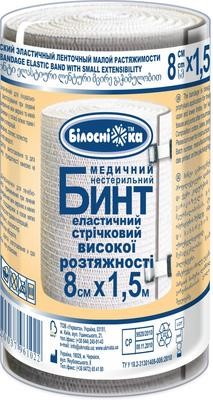
How to tie an elastic bandage correctly
The question: “how to tie an elastic bandage” can be answered very briefly - just like a simple bandage. Those. dressing with an elastic bandage should follow the schemes developed for dressing with a regular bandage.
Of course, there is a difference, it consists in the huge advantage of an elastic bandage - by creating additional continuous pressure (compression) perpendicular to its surface, it leaves soft tissues and joints the opportunity to move and function within certain limits.
This quality of the elastic bandage allows it to be used both for securing bandages and for treating injuries to the musculoskeletal system and diseases of the vascular and lymphatic systems. How to properly apply an elastic bandage
Before using an elastic bandage, let's consider the basic dressing schemes and the goals they serve.
Circular bandage.
We hold the edge of the bandage with our left hand, and with our right hand we make several rounds at the same level - as a rule, this is how they begin to apply an elastic bandage.

Spiral bandage - ascending and descending.
With an upward spiral, an elastic bandage is applied from bottom to top. With a downward spiral, you need to apply an elastic bandage from top to bottom: This is how you bandage your shin, hand or chest. Each subsequent round overlaps the previous one by about 1/3
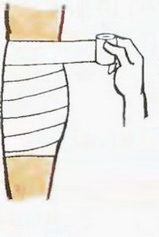
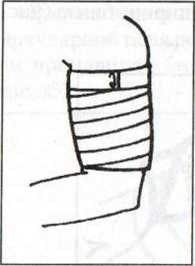

Creeping bandage
Very often we have to solve the following problem: how to properly apply an elastic bandage to a large surface. For example, the whole leg. To do this, you need to apply the bandage in two layers. In the first, we use a method similar to a spiral, but we do not overlap the previous round, but move away from it at a certain distance equal to the width of the bandage. And in the opposite direction we bandage or spiral, or some other method recommended by the doctor.

Cross-shaped (eight-shaped) bandage.
How to properly apply an elastic bandage to an ankle joint or knee is shown in the pictures below:
![]()
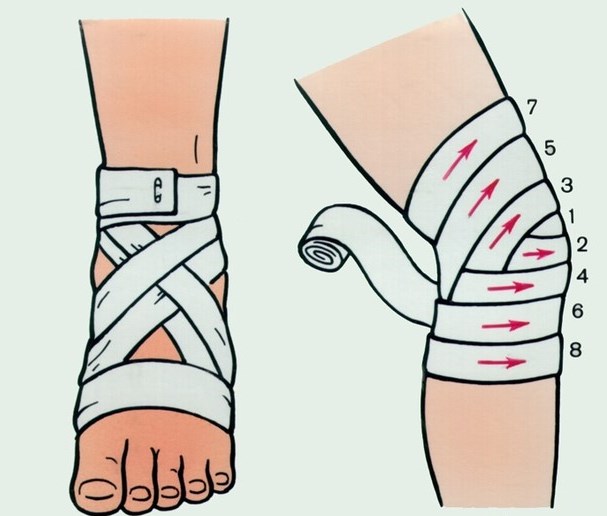
Spica bandage (a type of figure eight).
When applying it, the crosses are located along one line and are shifted at each round by ½ - 1/3 of the width of the bandage. The spica bandage recommends how to apply an elastic bandage to such dissimilar parts of the body as the first finger of the hand, shoulder and hip joints.

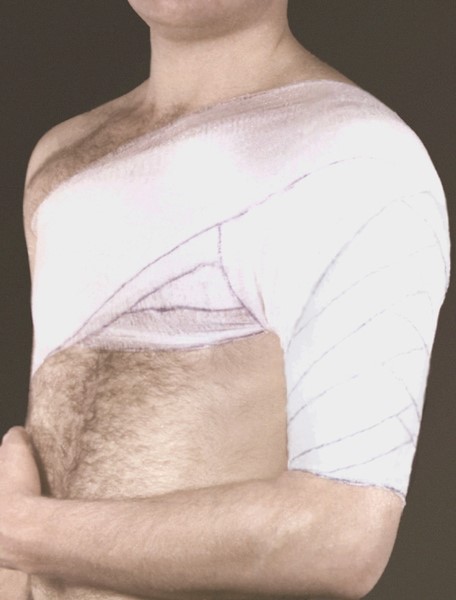
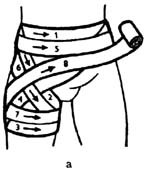
Turtle headband.
Bandaging the knee, elbow joint and heel with an elastic bandage is the most common procedure in everyday life.
Take a close look at the picture below, this is the so-called “Turtle” bandage for the knee joint:
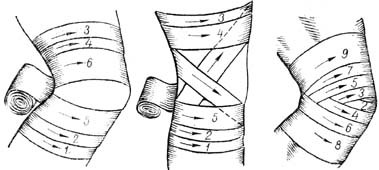
Left and center - we wrap an elastic bandage towards the center, this is a “converging” tortoiseshell bandage. But on the right we wrap an elastic bandage in “up and down” circles from the center - this is a diverging turtle bandage.
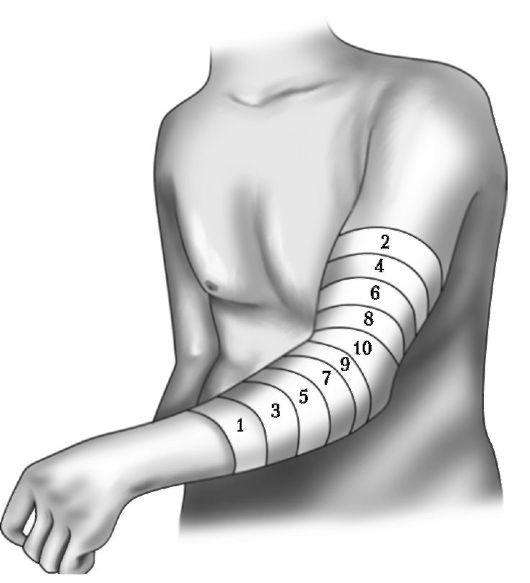
You can use an elastic bandage on the elbow joint in the same way.
But you need to figure out how to wrap an elastic bandage around your heel. We make 2 circular fixing rounds on the shin above the ankle and along the oblique side of the back of the foot we go to the ankle joint and fix it with a circular round. Now along the inside we go above the heel and again secure it in a circular manner:

To avoid a loose fit of layers 2 and 3, they are secured with an additional oblique bandage 4, running from the back surface of the ankle joint down and anteriorly to the outer lateral surface of the foot. Then they continue to apply diverging rounds of the tortoiseshell bandage. The bandage ends in circular circles in the lower third of the shin above the ankles.
How to apply an elastic bandage correctly
Here are some visual illustrations showing how to use an elastic bandage.



![]()
How to properly apply an elastic bandage for varicose veins
Of course, the correct advice would be to buy therapeutic tights with the required degree of compression. This applies to both women and men.
Firstly, both you and the doctor will know exactly what degree of compression occurs when putting on these tights, which means you will be able to make a decision in time to reduce or increase the compression load. Secondly, compression knitwear is made taking into account the graduation of compression - at the bottom it is greatest, and at the top it is no longer there. When bandaging yourself with an elastic bandage, this is the most difficult thing to do.
However, for a variety of reasons, you may find yourself without tights, but with an elastic bandage, so let's learn how to properly use an elastic bandage for varicose veins.
Firstly, we remember that we buy a bandage with maximum stretch. Secondly, we do not stretch the bandage while winding it to avoid increasing compression.
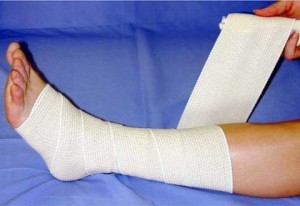
And now the doctor's advice:
- Perform foot binding in the morning while lying in bed without getting up). During this period of time there is no swelling or it is insignificant;
- An elastic bandage should be applied evenly without folds to avoid skin injuries when moving;
- An elastic bandage begins to be applied from the joints of the toes. The heel must also be bandaged, and when bandaging the heel, a so-called lock is formed, which will prevent the bandage from slipping when moving;
- A rolled bandage should only be unrolled outward and in close proximity to the skin. Only this technique allows you to avoid overstretching the bandage during application and, as a result, too much compression on the leg;
- Each subsequent turn of the bandage should overlap the previous one by 30 - 50%;
- At a minimum, the bandage should completely cover the entire foot and lower leg to the knee joint;
- The foot should be bandaged at a right angle in relation to the shin. Otherwise, walking will become very problematic;
- As you bandage, it is necessary to loosen the degree of compression;
- In order for the elastic bandage to stay better on the leg, especially on the thigh, it is best to apply layers of the bandage alternately in upward and downward directions - a so-called “herringbone” will be formed from the layers of the bandage;
- The bandaging should end 10-15 centimeters above the “sick” area of the leg;
- When applying an elastic bandage to complex leg shapes (such as, for example, ankles - with their “concavities” and “convexities”), it is recommended to “model the cylindrical profile of the limb” - lay latex or foam rollers between the bandage and the irregularities.
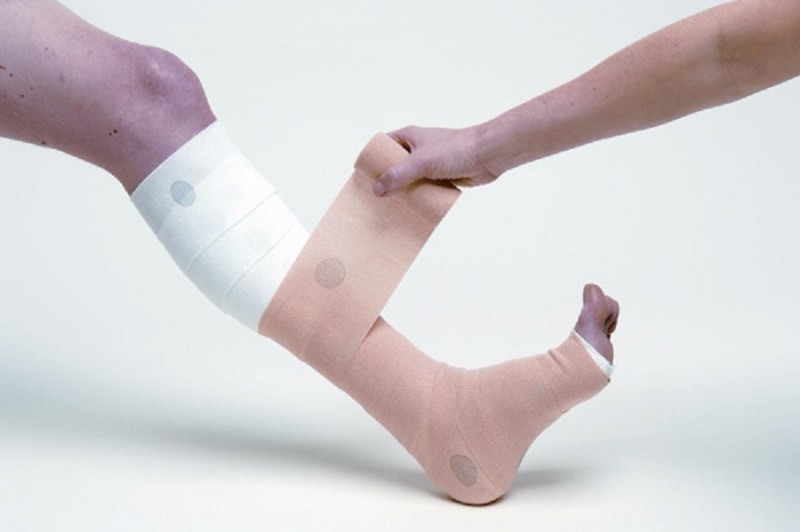
If you did everything correctly, after bandaging your fingertips will turn slightly blue. But they should restore their natural color when starting to move. Do not pull the bandage under the knee joint. This will seriously impede lymph flow, and the therapeutic effect of such a bandage will simply be destroyed.
After applying the elastic bandage, you need to walk for 20-30 minutes. If you observe symptoms such as numbness in your toes, a feeling of pulsation under the bandages, or the appearance of pain, you have bandaged your feet too tightly or the wrong class of elastic bandage has been selected for you.














